Dig this exciting news flash! Liberal 62 days of autumn and winter coastal razor clam digs tentatively set, and are dependent on additional marine toxin testing. Added bonus is a 20-clam daily limit up from normal 15-clams! Leave a reply
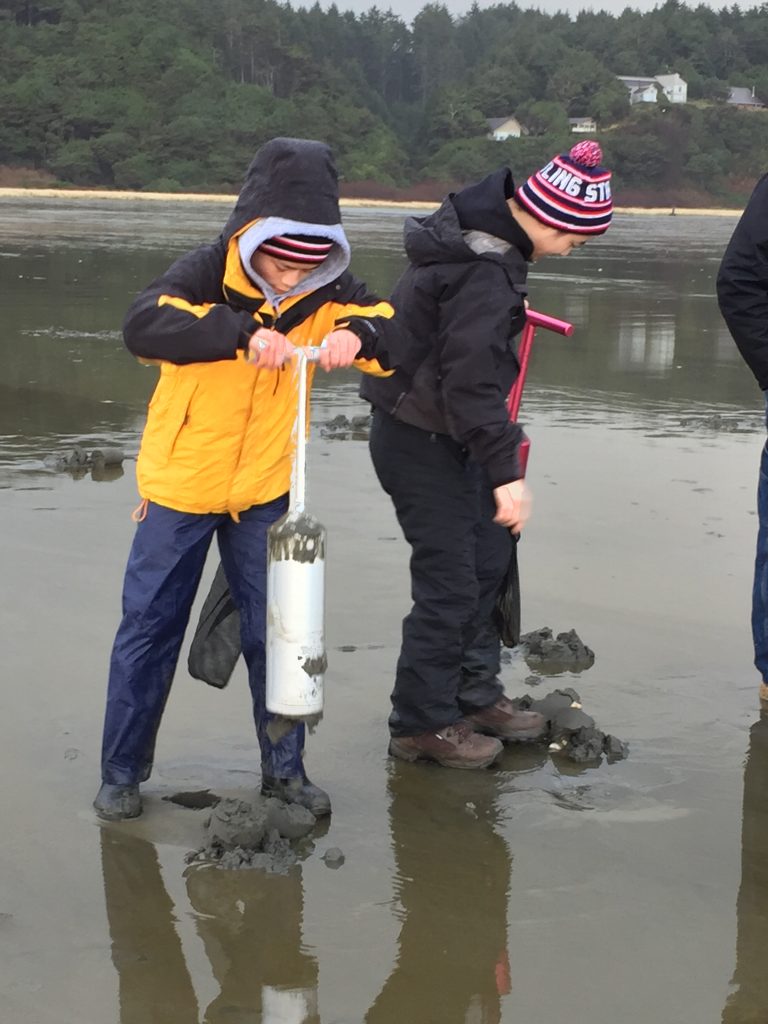
By Mark Yuasa
Time to mark coastal razor clam digging dates on the “to do” calendar!
The Washington Department of Fish and Wildlife (WDFW) announced today (Aug. 27) a copious amount of tentative digging dates beginning Sept. 17 through New Year’s Eve.
“Those first low tides will occur in the very early morning hours when it is still dark outside, and there’s generally not a lot of daylight low tides this fall,” said Dan Ayres, the head WDFW coastal shellfish manager.
“Many were asking about the holiday periods, and there are no tides that coincide with Thanksgiving (Nov. 25), but we’ve got some ideal periods the weekend before,” Ayres said. “The New Year’s Eve dig will allow revelers time to dig their clams before the evening festivities. Many people also like to stay on the beach after they dig their clams to light off fireworks.”
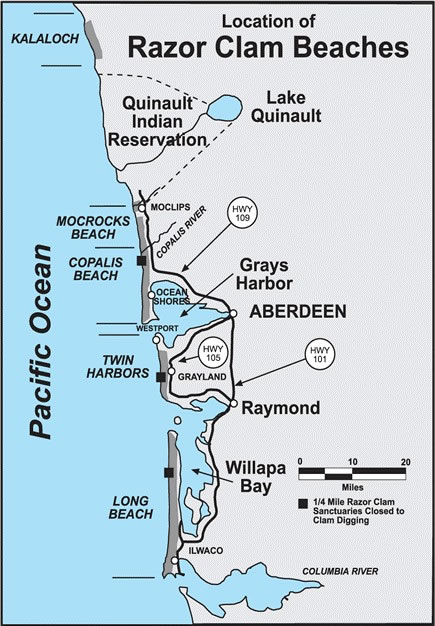
Here are the dates, which are dependent on marine toxin testing, which are usually made one to two weeks prior to each series of digs:
Morning low tides – Sept. 17, -0.4 feet at 4:30 a.m. at Long Beach, Twin Harbors, Mocrocks; Sept. 18, -0.5 at 5:22 a.m. at Long Beach, Twin Harbors, Copalis; Sept. 19, -0.6 at 6:06 a.m. at Long Beach, Twin Harbors, Mocrocks; Sept. 20, -0.5 at 6:45 a.m. at Long Beach, Twin Harbors, Copalis; Sept. 21, -0.2 at 7:21 a.m. at Long Beach, Twin Harbors, Mocrocks; and Sept. 22, 0.3 at 7:54 a.m. at Long Beach, Twin Harbors, Copalis.
Evening low tides – Sept. 23, 0.3 at 8:58 p.m. at Long Beach, Twin Harbors, Mocrocks; Sept. 24, 0.4 at 9:36 p.m. at Long Beach, Twin Harbors, Copalis; and Sept. 25, 0.5 at 10:15 p.m. at Long Beach, Twin Harbors, Mocrocks.
Morning low tides – Oct. 3, 0.2 at 4:52 a.m. at Long Beach, Twin Harbors, Copalis; Oct. 4, 0.0 at 5:33 a.m. at Long Beach, Twin Harbors, Mocrocks; and Oct. 5, -0.1 at 6:12 a.m. at Long Beach, Twin Harbors, Copalis.
Evening low tides – Oct. 6, -0.3 at 7:20 p.m. at Long Beach, Twin Harbors, Mocrocks; Oct. 7, -0.8 at 8:04 p.m. at Long Beach, Twin Harbors, Copalis; Oct. 8, -1.1 at 8:50 p.m. at Long Beach, Twin Harbors, Mocrocks; Oct. 9, -1.1 at 9:38 p.m. at Long Beach, Twin Harbors, Copalis; Oct. 10, -0.8 at 10:32 p.m. at Long Beach, Twin Harbors, Mocrocks; Oct. 11, -0.4 at 11:32 p.m. at Long Beach, Twin Harbors, Copalis; Oct. 19, 0.3 at 6:47 p.m. at Long Beach, Twin Harbors, Copalis; Oct. 20, 0.0 at 7:32 p.m. at Long Beach, Twin Harbors, Mocrocks; Oct. 21, -0.1 at 7:58 p.m. at Long Beach, Twin Harbors, Copalis; Oct. 22, -0.1 at 8:32 p.m. at Long Beach, Twin Harbors, Mocrocks; Oct. 23, 0.0 at 9:07 p.m. at Long Beach, Twin Harbors, Copalis; Oct. 24, 0.2 at 9:43 p.m. at Long Beach, Twin Harbors, Mocrocks; Oct. 25, 0.5 at 10:25 p.m. at Long Beach, Twin Harbors, Copalis; Nov. 3, -0.3 at 6:16 p.m. at Long Beach, Twin Harbors, Mocrocks; Nov. 4, -1.1 at 7:01 p.m. at Long Beach, Twin Harbors, Copalis; Nov. 5, -1.6 at 7:46 p.m. at Long Beach, Twin Harbors, Mocrocks; and Nov. 6, -1.8 at 8:33 p.m. at Long Beach, Twin Harbors, Copalis.
Switch to standard time during evening low tides – Nov. 7, -1.6 at 8:23 p.m. at Long Beach, Twin Harbors, Mocrocks; Nov 8, -1.2 at 9:16 p.m. at Long Beach, Twin Harbors, Copalis; Nov. 9, -0.6 at 10:13 p.m. at Long Beach, Twin Harbors, Mocrocks; Nov. 10, 0.0 at 11:16 p.m. at Long Beach, Twin Harbors, Copalis; Nov. 16, 0.5 at 4:50 p.m. at Long Beach, Twin Harbors, Copalis; Nov. 17, 0.1 at 5:28 p.m. at Long Beach, Twin Harbors, Mocrocks; Nov. 18, -0.2 at 6:03 p.m. at Long Beach, Twin Harbors, Copalis; Nov. 19, -0.3 at 6:37 p.m. at Long Beach, Twin Harbors, Mocrocks; Nov. 20, -0.3 at 7:10 p.m. at Long Beach, Twin Harbors, Copalis; Nov. 21, -0.2 at 7:44 p.m. at Long Beach, Twin Harbors, Mocrocks; Nov. 22, 0.0 at 8:21 p.m. at Long Beach, Twin Harbors, Copalis; Nov. 23, 0.2 at 9 p.m. at Long Beach, Twin Harbors, Mocrocks; Nov. 24, 0.5 at 9:43 p.m. at Long Beach, Twin Harbors, Copalis; Dec. 1, 0.1 at 4:09 p.m. at Long Beach, Twin Harbors, Copalis; Dec. 2, -0.8 at 4:58 p.m. at Long Beach, Twin Harbors, Mocrocks; Dec. 3, -1.5 at 5:45 p.m. at Long Beach, Twin Harbors, Copalis; Dec. 4, -1.9 at 6:32 p.m. at Long Beach, Twin Harbors, Mocrocks; Dec. 5, -2.0 at 7:20 p.m. at Long Beach, Twin Harbors, Copalis; Dec. 6, -1.7 at 8:09 p.m. at Long Beach, Twin Harbors, Mocrocks; Dec. 7, -1.2 at 8:59 p.m. at Long Beach, Twin Harbors, Copalis; Dec. 8, -0.6 at 9:51 p.m. at Long Beach, Twin Harbors, Mocrocks; Dec. 9, 0.1 at 10:45 p.m. at Long Beach, Twin Harbors, Copalis; Dec. 15, 0.6 at 4:28 p.m. at Long Beach, Twin Harbors, Mocrocks; Dec. 16, 0.1 at 5:07 p.m. at Long Beach, Twin Harbors, Copalis; Dec. 17, -0.2 at 5:43 p.m. at Long Beach, Twin Harbors, Mocrocks; Dec. 18, -0.3 at 6:18 p.m. at Long Beach, Twin Harbors, Copalis; Dec. 19, -0.4 at 6:52 p.m. at Long Beach, Twin Harbors, Mocrocks; Dec. 20, -0.3 at 7:27 p.m. at Long Beach, Twin Harbors, Copalis; Dec. 21, -0.2 at 8:02 p.m. at Long Beach, Twin Harbors, Mocrocks; Dec. 22, -0.1 at 8:38 p.m. at Long Beach, Twin Harbors, Copalis; Dec. 23, 0.2 at 9:16 p.m. at Long Beach, Twin Harbors, Mocrocks; Dec. 30, -0.1 at 3:49 p.m. at Long Beach, Twin Harbors, Mocrocks; Dec. 31, -0.9 at 4:42 p.m. at Long Beach, Twin Harbors, Copalis.
All open beaches (Long Beach, Twin Harbors, Mocrocks, and Copalis) will also have increased limits through the end of 2021 with diggers allowed to keep 20 clams instead of the usual 15. Each digger’s clams must be kept in a separate container, and all diggers must keep the first 20 clams they dig regardless of size or condition.
Additional razor clam digging dates in the winter and spring of 2022 will likely be announced sometime in December or early January.
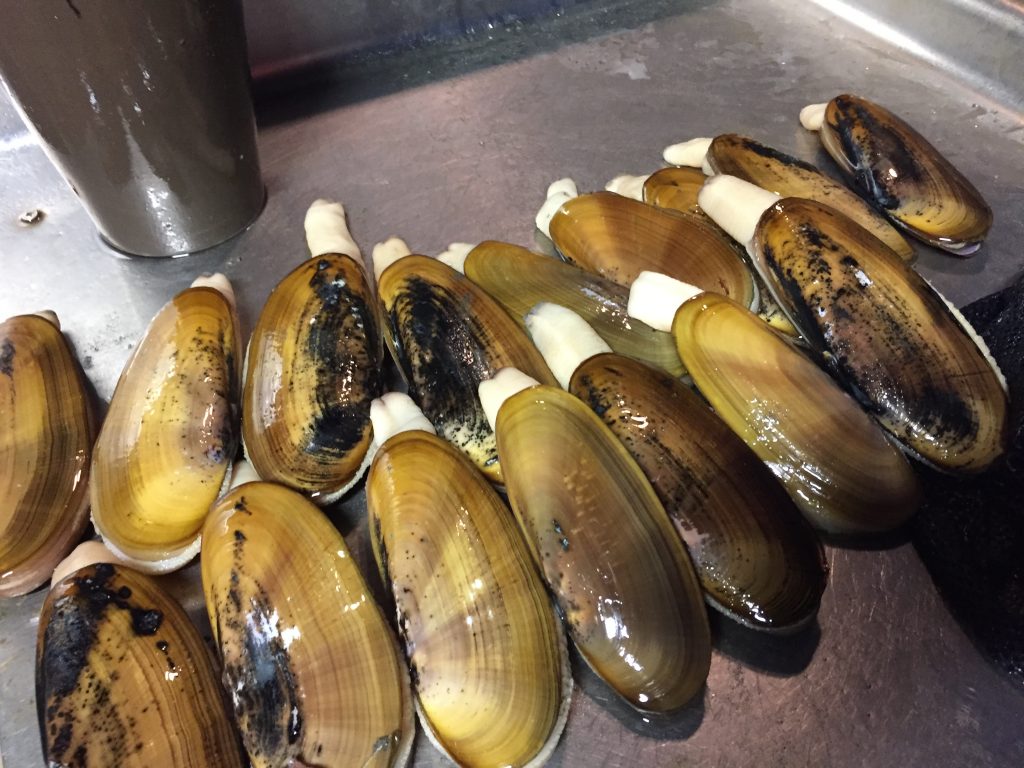
Summer assessments show acres of clams on beaches
Long Beach has 21.6-million recruit-size razor clams and a total allowable catch (TAC) of 8.6-million for the 2021-2022 season, which is slightly down from 24.8 million and 9.9-million respectively last season.
The historical average over the past 25 years is 7.9-million recruits at Long Beach, and outside of the 2020-2021 season there hasn’t been anything close to 21-milllion.
At Twin Harbors just south of Westport, assessments showed 8.5-million recruit-size clams (5.2-million last season) with a TAC of 3.4-million compared to 1.8-million last season. The previous record occurred in 2014-2015 season with 6.6-million recruit size clams.
At Copalis, the recruit-size clam total is 16.5-million (11.8-million last season) with a TAC of 6.6-million (recreational harvesters are allowed a share of 3.3-million) up from 4.7-million in 2020-2021.
At Mocrocks, the population isn’t a record number of recruit-size clams at 9.7-milllion down from 11.6-million last season, but still a decent population. The TAC of 3.9-million (recreational harvesters are allowed a share of 2.0-million) is down from 4.6-million last season but up from 3.3-million during 2019-2020.
According to Ayres, the northern-most beach is Kalaloch where the recruit-size number of razor clams is 800,000, which equates to 203,000 in the TAC.
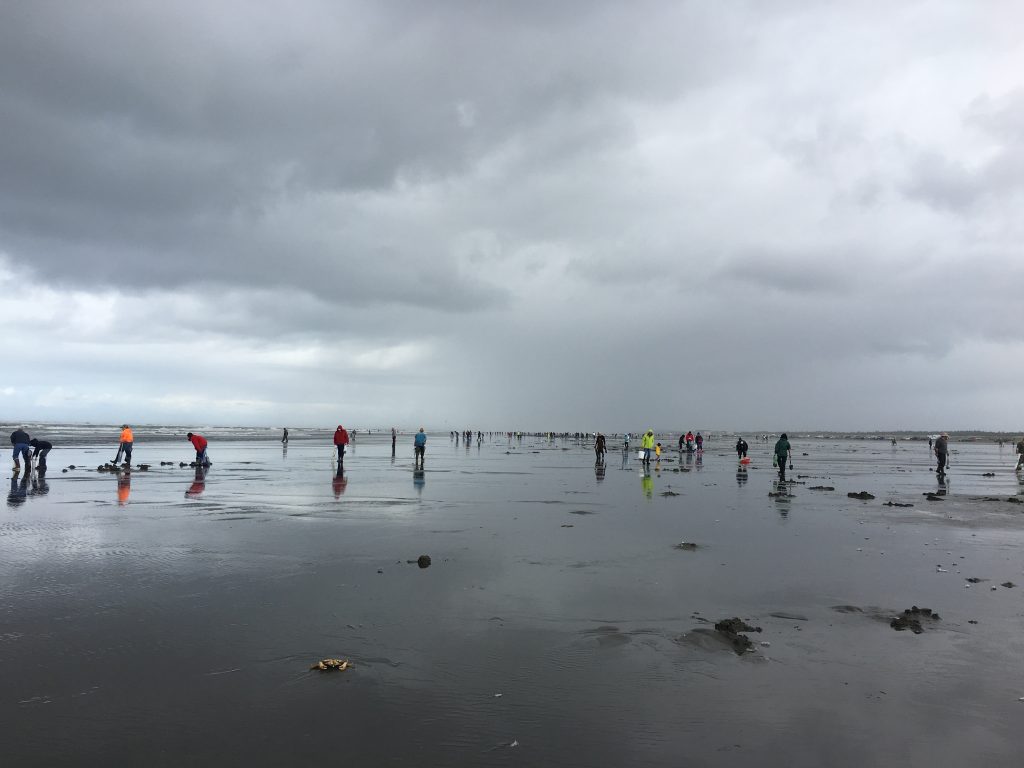
WDFW has already decided that digging at Kalaloch will remain closed during the 2021-2022 season. While there are 102,000 in the TAC, biologists saw very few clams that anybody would want to take home.
Marine toxin updates
Despite an enormous amount of digging days during the 2020-2021 season, much of them didn’t happen due to an outbreak of a marine toxin known as domoic acid – a natural toxin produced by certain types of marine algae – which can be harmful or even fatal if consumed in enough quantities.
“For the moment, marine toxin levels look good and mostly in the 1 to 2 parts per million (ppm),” Ayres said. “I heard from Oregon that their toxin levels are down and their razor clam assessments are also strong at Clatsop beaches.”
The Department of Health Labs get test samples of razor clam from WDFW regularly, and the action level is anything above 20 ppm.
“We did get a little spook of a rise of marine toxins at Copalis (earlier this month), but it dropped right back down,” Ayres said. “We know we aren’t out of the woods until we get a big fall storm, and I don’t expect that to happen anytime soon.”
Ayres says we are heading into a “ESNO” climate pattern – El Niño-Southern Oscillation – which is a recurring climate pattern involving changes in the temperature of waters in the central and eastern tropical Pacific Ocean. It is associated with colder water and air temperatures and increased rainfall during the autumn and winter period.
Furthermore, despite the hot inland weather, temperatures off the coast are quite cool and water salinity remains good.
Digging during the 2020-2021 season saw a coast-wide closure from the end of October through mid-May when just Mocrocks reopened for six days of digging on May 15, 17, 24, 26, 28 and 30.
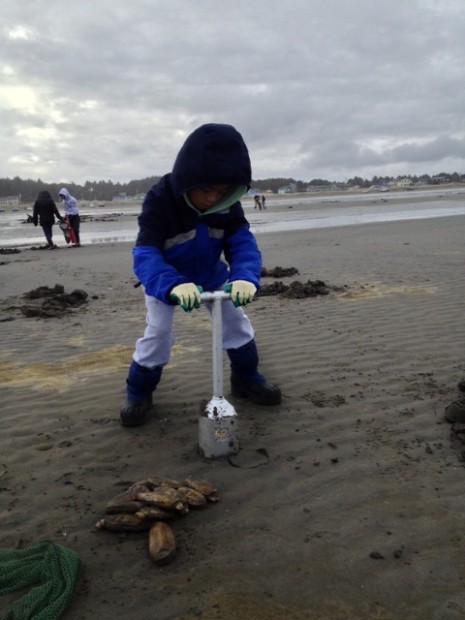
Since 1991, when the toxin was first detected on the Pacific Coast, outbreaks of domoic acid have prompted the cancellation of three entire razor-clam seasons in Washington — the last one in 2002-03. Twin Harbors Beach never opened in 2015-2016 as marine toxin levels never dipped below the action level. The entire coast was also closed in late May of 2015 when domoic acid spiked well above the cut-off level.
Razor clam digging is a huge money maker generating $25- to $35-million for small coastal communities who rely on these opportunities during the lean tourist times in autumn, winter and spring to help boost their economy.
When dates are announced they will still require final approval dependent on weekly marine toxin testing. The green light is usually announced one to two weeks prior to each series of digs.
Public health officials will continue to monitor COVID-19 issues in coastal communities, and officials are asking diggers to keep up social distancing, following local and state guidance on masks and face coverings, and be respectful of local communities and residents.
“We’re extremely grateful to everyone who helped this season come together, including local leaders, county health officers, and Washington State Parks,” said Larry Phillips, the WDFW coastal regional director. “We’ll be working hard to help ensure a safe, productive digging season, and the public can do their part by following health and safety guidelines.”
For more information on coastal razor clam digging, go to http://wdfw.wa.gov/fishing/shellfish/razorclams/.

